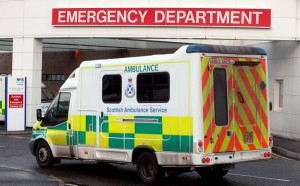AMBULANCE chiefs have blamed Scotland’s drinking culture for attacks on paramedics soaring by more than a third over the past three years.
Shocking figures from the Scottish Ambulance Service (SAS) show the number of assaults on crews jumped from 228 in 2010 to 306 in 2012.
Emergency workers found themselves the victims of “pushing, punching and spitting” as well as being assaulted with weapons.
The figures also reveal the most dangerous ambulance stations in Scotland – where attacks doubled over the same period.
And the incidents were not restricted to frontline workers. A trainee paramedic was assaulted while at college while another occurred at the SAS national headquarters.

A spokesman for the ambulance service said the incidents were “unacceptable”, adding: “In the majority of cases where crews are threatened or assaulted, alcohol is a key factor in the incident.”
Figures obtained through a Freedom of Information request show 839 verbal and physical attacks were recorded over the past three years.
Edinburgh emerged as the most dangerous ambulance station at which to be based with 100 attacks on paramedics over the three years.
There were 191 assaults recorded at Glasgow ambulance stations over the period – 63 in the south, 61 in the central Springburn area, 37 in the west and 30 in the east.
Attacks at Glasgow West more than doubled over three years from seven in 2010 to 16 last year.
Elsewhere since 2010, there have 38 incidents at Paisley, 29 at Hamilton, 28 each at Aberdeen, Coatbridge and Cowdenbeath, 27 in Clydebank and 26 in Stirling.
An SAS spokesman said: “Ambulance staff undertake a difficult and challenging job in often extreme situations.
“Increasingly they are subjected to verbal abuse from the public on an almost daily basis as they go about their job.
“Every year ambulance crews report incidents of physical assault ranging from pushing and punching to spitting and attack with a variety of weapons – this is totally unacceptable.
“They regularly respond to incidents where patients are hurt as a result of violence and to situations, which on arrival at scene may appear to be perfectly safe and innocuous, but quickly change to something more threatening.
He added: “If any ambulance crews feel that their safety may be compromised, they are instructed to hold nearby the scene and await support from the police, or additional ambulance crews.”
